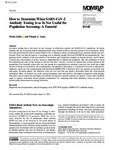How to Determine When SARS-CoV-2 Antibody Testing Is or Is Not Useful for Population Screening: A Tutorial
Keller, Niklas
Jenny, Mirjam A.
Extensive testing lies at the heart of any strategy to effectively combat the SARS-COV-2 pandemic. In recent months, the use of enzyme-linked immunosorbent assay–based antibody tests has gained a lot of attention. These tests can potentially be used to assess SARS-COV-2 immunity status in individuals (e.g., essential health care personnel). They can also be used as a screening tool to identify people that had COVID-19 asymptomatically, thus getting a better estimate of the true spread of the disease, gain important insights on disease severity, and to better evaluate the effectiveness of policy measures implemented to combat the pandemic. But the usefulness of these tests depends not only on the quality of the test but also, critically, on how far disease has already spread in the population. For example, when only very few people in a population are infected, a positive test result has a high chance of being a false positive. As a consequence, the spread of the disease in a population as well as individuals’ immunity status may be systematically misinterpreted. SARS-COV-2 infection rates vary greatly across both time and space. In many places, the infection rates are very low but can quickly skyrocket when the virus spreads unchecked. Here, we present two tools, natural frequency trees and positive and negative predictive value graphs, that allow one to assess the usefulness of antibody testing for a specific context at a glance. These tools should be used to support individual doctor-patient consultation for assessing individual immunity status as well as to inform policy discussions on testing initiatives.
Files in this item

